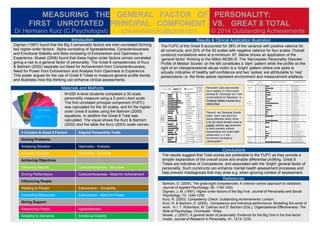More Related Content
Similar to Kurz (2014) MEASURING THE GENERAL FACTOR OF PERSONALITY EPA Conference Munich
Similar to Kurz (2014) MEASURING THE GENERAL FACTOR OF PERSONALITY EPA Conference Munich (20)
Kurz (2014) MEASURING THE GENERAL FACTOR OF PERSONALITY EPA Conference Munich
- 1. Digman (1997) found that the Big 5 personality factors are inter-correlated forming two higher-order factors: Alpha consisting of Agreeableness, Conscientiousness and Emotional Stability and Beta consisting of Extraversion and Openness to Experience. Musek (2008) found that these higher-order factors remain correlated giving a rise to a general factor of personality. The Great 8 competencies of Kurz & Bartram (2002) separate out Need for Achievement from Conscientiousness, Need for Power from Extraversion and Analysis from Openness to Experience. This poster argues for the use of Great 8 Totals to measure general profile trends, and illustrates how this thinking can enhance clinical assessments.
Introduction
Materials and Methods
N=250 A-level students completed a 30 scale personality measure using a 5 point Likert scale. The first unrotated principal component (FUPC) was calculated for the 30 scales, and for the higher- order Great 8 scales using the Bartram (2005) equations. In addition the Great 8 Total was calculated. The visual shows the Kurz & Bartram (2002) and the table the Kurz (2003) scale names.
Results & Clinical Application Illustration
The FUPC of the Great 8 accounted for 38% of the variance with positive valence for all constructs, and 20% of the 30 scales with negative valence for four scales. Overall construct correlations were at a minimum .97. Below shows an application of the ‘general factor’ thinking to the Millon MCMI-III. The ‘Narcissistic Personality Disorder: Profile of Median Scores’ on the left constitutes a ‘dark’ pattern while the profile on the right of an intergenerational abuse victim is a ‘bright’ pattern where one spike is actually indicative of healthy self-confidence and two ‘spikes’ are attributable to ‘real’ persecutions i.e. the three spikes represent environment and measurement artefacts.
The results suggest that Total scores are preferable to the FUPC as they provide a simpler explanation of the overall score and enable differential profiling. Great 8 Totals are indicative of Competence, and associated with the ‘bright’ general factor of personality. Such constructs can enhance mental health assessment processes and help prevent misdiagnosis that may arise e.g. when ignoring context of assessment.
Conclusions
Bartram, D. (2005). The great eight competencies: A criterion-centric approach to validation. Journal of Applied Psychology, 90, 1185-1203.
Digman, J. M. (1997). Higher-order factors of the Big Five. Journal of Personality and Social Psychology, 73, 1246-1256.
Kurz, R. (2003). Competency Check. Outstanding Achievements: London.
Kurz, R. & Bartram, D. (2002). Competency and individual performance: Modelling the world of work. In I. T. Robertson, M. Callinan and D. Bartram (Eds.), Organizational Effectiveness: The Role of Psychology. Chichester: Wiley.
Musek, J. (2007). A general factor of personality: Evidence for the Big One in the five-factor model. Journal of Research in Personality, 41, 1213–1233.
References
4 Clusters & Great 8 Factors
Aligned Personality Traits
Solving Problems
Analysing Situation
Openness - Analysis
Creating Concepts
Openness - Creativity
Achieving Objectives
Delivering Results
Conscientiousness - Structure
Driving Performance
Conscientiousness - Need for Achievement
Influencing People
Relating to People
Extraversion - Sociability
Controlling Resources
Extraversion - Need for Power
Giving Support
Respecting People
Agreeableness
Adapting to Demands
Emotional Stability
‘Paranoid’ and ‘Delusional Disorder’ scales ‘share’ many items thus lacking differential validity. Abuse victim got slightly elevated scores as truthfully reporting ‘real’ persecution by family members, authority representatives and mental health professionals i.e. a ‘toxic’ environment (mis-)leads to ‘pathologisation’.
‘Narcissistic’ scale score elevated due to negation of 3 items scored positively for ‘Schizotypal’ and 1 item scored positively for ‘Depression’ i.e. ‘Emotional Stability’ is turned into a mental illness.
MEASURING THE GENERAL FACTOR OF PERSONALITY:
FIRST UNROTATED PRINCIPAL COMPONENT VS. GREAT 8 TOTAL
Dr Hermann Kurz (C.Psychologist) ichinendaimoku@gmail.com © 2014 Outstanding Achievements
